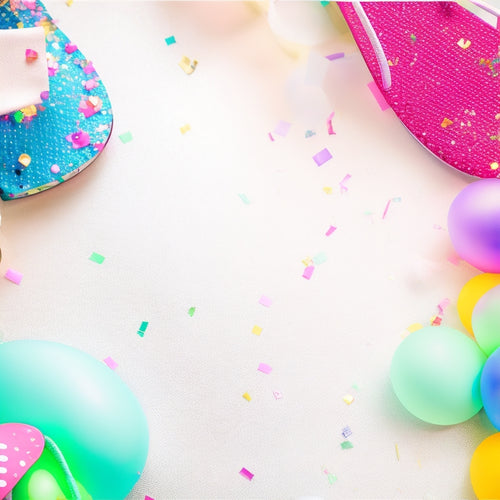
Unleash Your Passion: Dance Instructor's Inspiring Journey
Share
With an unwavering passion for movement and self-expression, dance instructors have the unique opportunity to inspire and empower others, shaping the next generation of dancers and fostering a lifelong appreciation for the art form. By embracing various dance styles, effective teaching techniques, and nurturing environments, instructors can ignite their passion and creativity. Pursuing a career in dance requires technical expertise, continuous training, and a commitment to growth. As instructors refine their skills and knowledge, they open the door to a journey of discovery, inspiring others to do the same, and ultimately, tapping into the full potential of dance.
Key Takeaways
• Embrace your passion for dance by exploring various dance styles to find your unique voice and expression.
• Develop your technical expertise and creativity through formal education, training, and continuous learning.
• Create a nurturing environment that fosters authentic self-expression and positive reinforcement for your students.
• Refine your teaching abilities through certifications, specialized training, and networking with experts in the field.
• Set achievable goals and develop a personal growth plan to continuously improve and stay inspired as a dance instructor.
Embracing the Art of Dance
As the rhythmic beats of music converge with the expressive movements of the human body, the art of dance comes alive, igniting a passion that fuels the soul and motivates the dancer to embark on a lifelong journey of creativity and self-expression.
Embracing the art of dance involves exploring various dance styles, such as ballet, contemporary, and hip hop, to discover one's unique creative voice. Employing effective teaching techniques, like positive reinforcement and constructive feedback, can inspire students to tap into their full potential.
When teaching dance, creating a nurturing environment that fosters creativity, builds confidence, and motivates students to express themselves authentically is crucial. By embracing the art of dance, instructors can spark a love for movement and self-expression in their students, cultivating a lifelong passion for the art form.
Pursuing a Career in Dance
How does one navigate the multifaceted world of dance instruction, where passion, creativity, and technical expertise converge to inspire a new generation of dancers? Pursuing a career in dance requires a deep exploration of various dance styles, enhancing teaching techniques, and seizing professional development opportunities.
A strong foundation in formal education and training is essential, with a Bachelor of Arts or Bachelor of Fine Arts in dance being common qualifications. Continuous training and participation in workshops and masterclasses are crucial for career advancement.
Continuing Education and Growth
Through a dynamic interplay of workshops, masterclasses, and continuous training, dance instructors can refine their craft, stay abreast of the latest trends, and propel their careers forward. This commitment to lifelong learning fosters professional development, enabling instructors to stay current and adapt to the ever-evolving dance landscape.
-
Pursue certifications and specialized training to enhance teaching abilities
-
Attend conferences and seminars to network with peers and industry experts
-
Engage in online courses and webinars to stay updated on best practices
-
Participate in peer-to-peer mentoring and feedback programs
-
Develop a personal growth plan, setting achievable goals for continuous improvement
Frequently Asked Questions
How Do I Balance Teaching With My Own Dance Practice and Performance Goals?
'Effective time management and setting personal boundaries are essential to balancing teaching with personal dance practice and performance goals, allowing instructors to prioritize self-care, maintain energy, and fuel their passion for dance.'
What Are Some Effective Strategies for Managing Classroom Behavior and Discipline?
To maintain a harmonious learning environment, implement effective classroom management strategies, such as positive reinforcement, clear expectations, and proactive discipline techniques, fostering a respectful atmosphere where students thrive and focus on mastering dance techniques.
How Can I Adapt My Teaching Style for Students With Physical or Learning Disabilities?
By embracing accessible choreography and crafting inclusive lessons, dance instructors can foster a welcoming environment for students with physical or learning disabilities, empowering them to tap into their full potential and shine.
What Are Some Ways to Engage and Motivate Students Who Are Not Naturally Inclined Towards Dance?
To engage and motivate students not naturally inclined towards dance, try incorporating creative breakthroughs, dance games, and fun routines. Inspirational stories, kinesthetic learning, and movement exploration foster excitement, while personalized feedback, reward systems, student reflections, and visual aids promote confidence and enthusiasm.
How Do I Handle Criticism or Negative Feedback From Students, Parents, or Administrators?
When dealing with criticism, maintain a growth mindset, embracing constructive feedback as an opportunity for self-reflection and improvement. Remain open, empathetic, and professional, using criticism to refine teaching methods and foster a supportive dance community.
Related Posts
-

Why Hip Hop Dancers Need Flawless Makeup Tutorials
You need a flawless makeup look that can keep up with your high-energy hip hop dance routines, emphasizing the import...
-

Dazzling Ballet Ticket Unveiled
The anticipation is over, as the dazzling ballet ticket design has finally been revealed, exuding elegance and sophis...
-

Get the Dance Floor Popping: Wedding Flip Flops Sign
Create a memorable and entertaining wedding reception with a 'Get the Dance Floor Popping' flip flops sign that combi...


